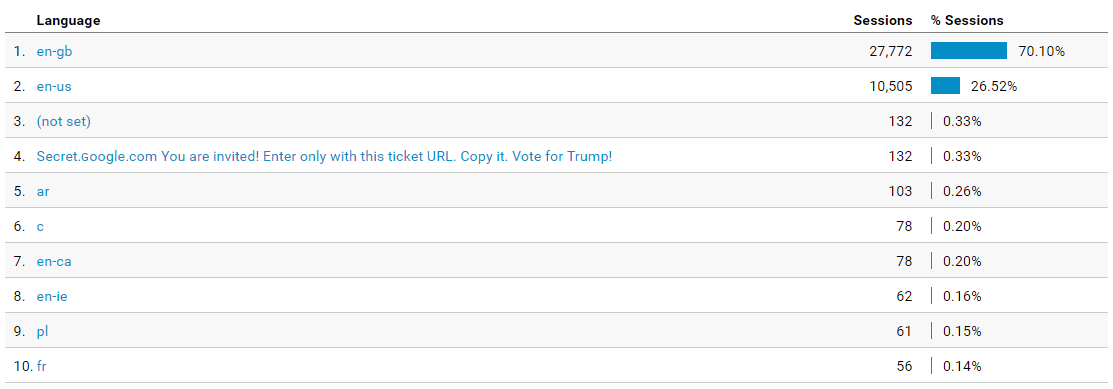As 2016 draws to a close (and frankly, good riddance!), I thought I’d take some time to reflect on the year in digital which brought us Penguin 4.0, tablet-specific bid modifiers in Google Adwords, the official integration of AMP listings in Google’s mobile search results and mobile-first indexing.
With all these (and many more) potentially game-changing revelations, our clients naturally had questions about how they would be affected. This article covers off seven of the most common questions we received from clients throughout 2016.
How much emphasis should I be placing on mobile?
Short answer… A significant amount!
Longer answer… We all know that mobile website usage has been on the rise since the advent of smartphones, and with mobile traffic surpassing desktop traffic in many of our clients’ accounts, a mobile-first approach to both website design and marketing has never been more important. Overlay this with Google’s mobile-friendly algorithm update in April 2015 (dubbed Mobilegeddon) and their move to mobile-first indexing in November this year, and you can clearly see that Google is keen that mobile users are appropriately accommodated.

Is programmatic display advertising appropriate for my business?
Short answer… Yes, as long as you have the right budget and are prepared to give it time.
Longer answer… Display advertising has exploded in recent years – no longer is it synonymous with banner ads that have incredibly low CTR’s and conversion rates, and no longer does it involve selecting websites that you think meet your target demographic and negotiating a price with that site’s publisher. Nowadays this whole process can be automated and better still, we can target by person, not just by where we expect that person to go.
Programmatic display learns about the types of people that convert and which websites they visit, and over time is able to build a profile of a typical converter to automate the targeting process. The decision as to whether you should include programmatic display in your marketing mix should be based around whether you have the budget to attract the amount of traffic you will need in order for this process to work, and whether you are prepared to give it the time it needs to bed in and learn. With both of these elements in place programmatic display could prove to be an extremely effective marketing channel.
Should I be using attribution modelling?
Short answer… It depends on whether your users tend to have multiple interactions with your ads/website prior to conversion.
Longer answer… Marketers are starting to cotton on to the idea that giving all the credit to the last interaction before conversion is not necessarily an accurate way to measure the effectiveness of a marketing channel – just because someone clicked on a paid search ad and converted doesn’t mean that they didn’t see a programmatic display ad, head to Youtube and watch one of your explainer videos, visit your website to research, get followed round the web by your remarketing banners and then finally performed a brand search.
Attribution modelling can help us distribute credit using various self-defined techniques, but before investing in this it’s important to establish whether there is an attribution issue – this is where Multi-Channel Funnel Reports in Google Analytics can help. It may be that the vast majority of your conversions come as a result of only 1 or 2 interactions, in which case attribution modelling is potentially less helpful than if (let’s say) 35% of your conversions have over 3 prior interactions.
Is there a way of stopping spam referrals in GA?
Short answer… Not really.
Longer answer… If you’re seeing a lot of referral traffic from domains ending in “.xyz” or strange, unknown languages such as number 4 below then you’ll be painfully familiar with spammy GA data:

It all started with semalt.com which started appearing under our referral traffic in Google Analytics back in 2014 – a dubious SEO tool which used somewhat unethical means to attract visitors to their site, essentially sending fake traffic from the domain. Since then, many others have followed suit to the extent that for some sites with relatively low levels of traffic, these spam referrals can be significantly skewing their overall visitor data.
Unfortunately there is no one way of ensuring that this spam doesn’t appear in your Google Analytics account, and instead we are required to perform regular investigations into each client’s website traffic, retrospectively excluding these visits using GA filters. There are many articles detailing the ways in which you can apply these filters, and staying on top of them is advisable in order to maintain the integrity of your visitor data.
How will we be affected by the removal of right hand side ads in the search results?
Short answer… You’ll need to ensure you’re in the top 4 positions in order to attract a high volume of clicks!
Longer answer… In February 2016 Google made a drastic change to the way it displays its ads, completely stripping everything from the right-hand side of search results. This appeared to be an effort to both increase ad revenues (of course!) and to bring desktop SERPs more in line with how they appear on mobile devices.
The results were as expected, with CTR’s for top ad positions increasing and anything with an average position of 5 or lower plummeting. In addition, with the increased emphasis around ad extensions such as sitelinks, callouts and structured snippets etc pushing organic listings further down the page, organic CTR’s appeared to drop.
As a result, it is more important than ever to ensure that your ads appear in those top 4 spots if you’re looking to attract high volumes of clicks via Google Adwords.
Do I need AMP pages?
Short answer… Yes, for readable content.
Longer answer… In February 2016 Google officially integrated AMP listings into its mobile search results. If you’re unfamiliar with AMP (Accelerated Mobile Pages), they are essentially a stripped back, much faster loading version of your page, appearing only for mobile searches.

That said, there are a multitude of restrictions given the “stripped back” nature of the code involved in AMP, meaning that conversion-led lead generation or e-Commerce pages which will benefit from conversion optimisation and layout tweaks etc will perhaps not be so appropriate for AMP.
Should we be bidding on our brand terms?
Short answer… Yes
Longer answer… It’s been a debate that has gone on for years – “Should I be paying for traffic that I’m probably going to get organically for free?”. We have always advocated the use of brand campaigns, having seen significant evidence across multiple clients in multiple industries that brand ads + organic clicks = more clicks than no brand ads + organic clicks.
Combine this with the fact that on mobiles your organic listing may appear in position 5, plus the added flexibility you have due to callout extensions and sitelinks which allow you to promote specific products/services/offers etc, and brand bidding clearly presents a multitude of benefits (at a very low cost).
An additional benefit of bidding on your brand terms is that if you don’t, your competitors might! This could lead to the loss of prospective customers who (either knowingly or unknowingly) click on your competitor’s ad and make their enquiry with them. Even if your competitors are not currently bidding on your brand terms, having a paid presence may dissuade them since their quality scores will inevitably be lower, meaning they will spend a lot more on clicks than you would, potentially making it less of a viable option for them.
If you have any questions I’ve not covered, feel free to drop them in the comments.
